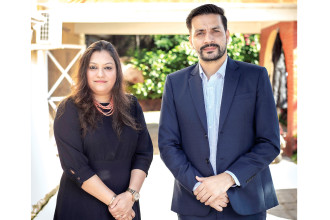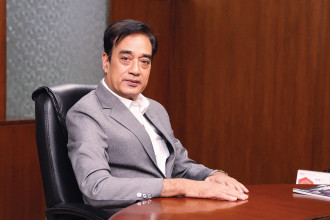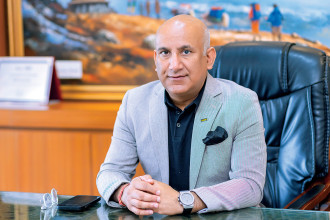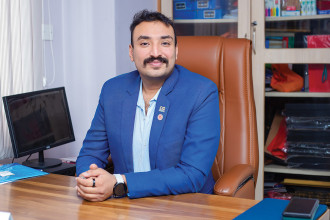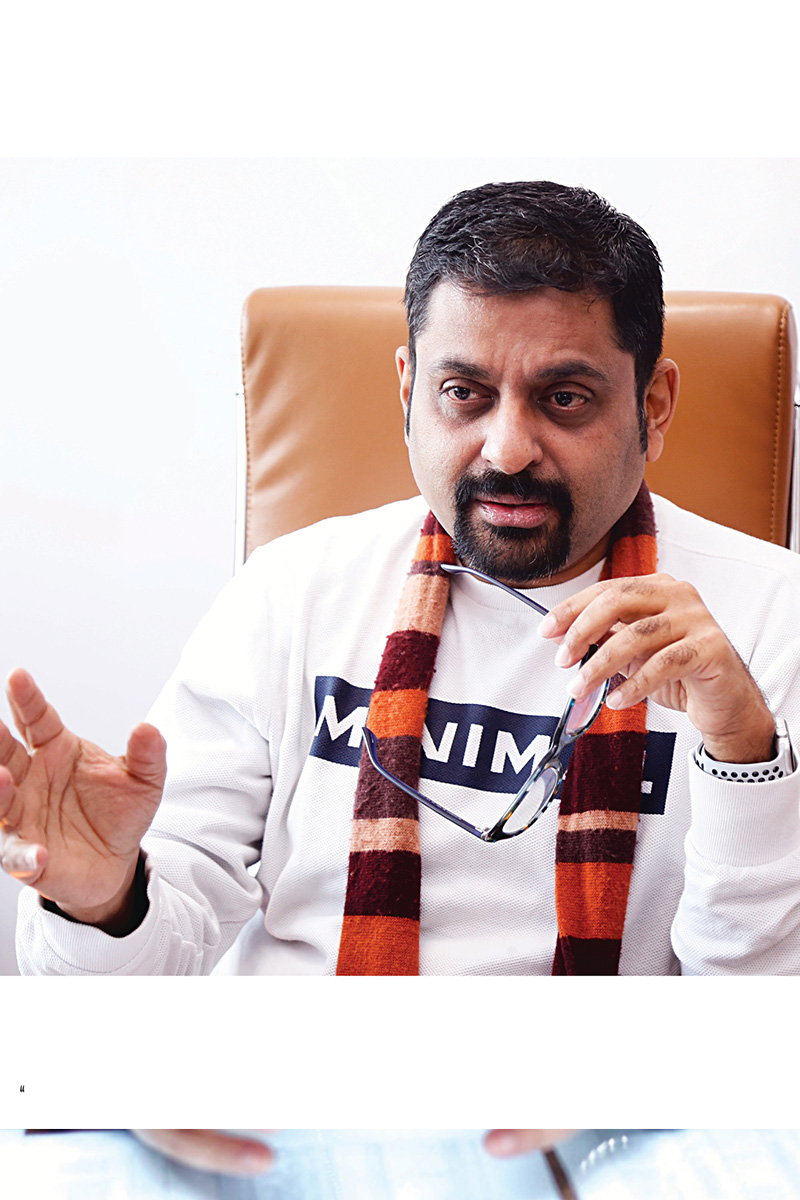
Sudhakar Jayaram has significant experience leading projects focused on healthcare and technology. He has a successful track record of 24 years working across geographies including India, China, Nepal, UAE and USA. Currently, he is the CEO of Nepal Mediciti, a 750 bed quaternary care hospital in the valley. He has been involved from project commissioning and is leading the execution.
In an interview with Ankita Jain of B360˚, Sudhakar Jayaram talks about the country’s need in terms of healthcare facility, challenges and the way forward. After Right to Education and Right to Food, do you think that the time has come for Right to Healthcare legislation given the poor state of public healthcare infrastructure in this country?
In a country, there are two fundamental keys that I think determine sustainable growth. One is education and the other is health. Looking at the health sector, there are several budgetary and other constraints but at least healthcare at a primary level and to some extent at the secondary level must be universally available.
If you take the rural population of Nepal into consideration, maybe not even 40% have access to basic healthcare. Considering how the hospitals will be funded and monitored, I think there is a greater need for public-private partnership. Today there is a level of mistrust among people about the health system of the country. Public healthcare institutions today are not seen as the highest quality in terms of delivery of care.
Another factor where we are lacking is the primary healthcare system. This is where the government can come in because what happens is that people come to a big hospital even for a minor stomachache, fever and others. These things can be done at a primary level reducing the cost and improving access.
There is the concept of a social heart and business brain trending. How does one strike a balance?
In my view, the hospital has to be service-oriented first before it becomes a business. However, we have to make it financially sustainable as well. I don’t believe that charity is a scalable or sustainable model; even NGOs have to find ways to keep their operations running.
When Nepal Mediciti started, the idea was that it is a socio-commercial project and needs to have a social impact and at the same time there is a commercial component that banks into money. The interest rate is extremely high in this country and we have to make sure that the banks are paid. So, obviously, we have to make this viable. Further, we are implementing social impact in multiple ways.
First, we are connecting to all stronger peripheral hospitals of Nepal through telemedicine. Through this, we are giving the doctors in many smaller hospitals access to our specialists and also train them when they receive complex cases. So they are able to stabilise and also the patients do not have to travel all the way unless there is a requirement. Second, we are recommending the government to form an international patient safety council. It will be an autonomous body which will keep an eye on quality. Many hospitals in rural areas do not even have a quality department. In order to make these hospitals safe, we have come up with simple sets of guidelines and rules which have to be followed. And we are giving this at no cost to the government and health ministry so that they can then share it with hospitals, if interested. Similarly, we can also provide trainings because we have gone through this process and we would be the first hospital in the country to receive the NABH certification from India. Third, we are working with insurance companies to provide cashless treatment.
Today people think private hospitals can be expensive, some of them really are. So, we are trying to reduce the price by publishing our cost and getting involved in cost accounting so that we can reduce the cost and make it affordable. Further, if we have good partnerships with NGOs, government and public hospitals, we can create both social impacts and also run profitably. In a country like Nepal, we have to move the money towards preventive measures because once people become too ill, the cost becomes high. So, the biggest social impact that I see is by focusing on screening and prevention.
How do you perceive the role of the government in ensuring affordable healthcare?
I think mandatory health insurance is the way forward. For instance, if you want to drive a motor vehicle in Nepal, one must have car insurance. But you must also have health insurance which currently is not mandatory. Are you telling me that you can go around the road without health insurance but not without car insurance? If the government says there are around 29 million people in Nepal and all of them cannot afford a hefty amount of health insurance, then I believe they can pay a small amount of money may be Rs 1,000 per year. This money will later help the government to create a pool of money which can be available to people for screening.
Further, since we cannot get foreign doctors to help our Nepali doctors with complex cases, when the need arises rather patients have to travel outside the country. But if the government makes it easy for foreign doctors either from India or the West to come here and help fellow doctors, it will pave the way towards creating capacity. Then we can increase our ability to better services within our country. Also, I think there should be some kinds of regulations in place. I believe if Nepal Mediciti can work closely with the Teaching Hospital or Patan Hospital, there are many ways in which our institute can help. Today, I feel that engagement and level of collaboration between private and public institutions is either missing or not utilised to the optimum degree. They have great pool of data, excellent professors and there must be ways in which we can work and share knowledge.
Your comments on the rising incidents of medical malpractice which are seemingly driven by the urge to make inordinate profits across the country by those in the health business…
All doctors swear on the Hippocratic Oath and the first thing they say is ‘we will do no harm’ but human nature is such that at times greed rules. I believe that one of the things that could be done against malpractice is making it mandatory for hospitals to publish data. A hospital must publish its clinical indicators. For example, what is your mobility, mortality and so on. There are many clinical indicators which tell you how good a hospital is. If we make it mandatory for health institutes to publish their outcomes, it will be easy to judge hospitals and make choices accordingly. Even an insurance company will have a say in supporting a particular hospital because it’s safer.
I don’t think regulation is the answer and I don’t even support a government initiative to jail or fine a particular doctor if found involved in malpractice. It may not be the best way because there are rotten apples everywhere. But I believe one way to solve this is by empowering their decision through publication of hospital outcomes.
Healthcare management has been the key factor in developing Nepal Mediciti. How important is research and analysis?
I am a silent CEO; I do not like to come in the front. I am always in the back and leading my team. If you ask me, I only have to worry about two things: position alignment and patient engagement. In most hospitals, the problem is between the so-called management and doctors. Doctors are highly educated; they cannot be managed and rather need not to be managed. So, I work with doctors in a manner where we share data related to medicine, economics and safety in an open atmosphere. I think the only way to change a doctor’s behaviour is by sharing data. Second is patient engagement. How honest are we with our patients at the front desk? We can make mistakes but we must own up to it and try to correct it. If position alignment, patient engagement and safety fall into place, patients will come automatically. Thereby, we will be full, our occupancy will be good, and we will be able to pay our staff.
Currently, Nepal Mediciti is focusing largely on building the pathway for medical tourism. What are the plans?
I remember the current Prime Minister once said that we should make Nepal a medical hub. In my mind, Nepal has an opportunity in four areas: tourism, medicine, agriculture and education. I am not including hydropower because Nepal can generate hydropower but for distribution, transmission, purchases, you still are dependent on India and other countries. But if you take the above four sectors, we need not depend on anybody and I believe we can combine medicine and tourism because everybody loves Nepal. In South Asia, it is a country that has no polarisation and therefore people are very open-hearted. I am also convinced that today the amount of foreign exchange that goes out of the country for healthcare and education is probably much more than what the country earns. Therefore, I think that setting up a medical tourism hub where we give medical visas and make it easy for patients to come to Nepal will help immensely. We should give licenses to doctors to come and practice and make it easy for them. Since land allocation is the problem in the valley, we should also change some policies for land availability so that projects can come in in a more sustainable and feasible manner.
[su_pullquote align="right"]I feel that engagement and level of collaboration between private and public institutions is either missing or not utilised to the optimum degree.[/su_pullquote]
How is Nepal Mediciti ensuring the delivery of quality, accessibility, availability and affordability of healthcare across the country?
In the following ways:
• We have not compromised on the quality of diagnosis.
• All our doctors are available here full time. This leads to teamwork because one patient can come with multiple problems. This makes us safer.
• We have also tried to constantly price ourselves to be more affordable as compared to other private hospitals.
• We are connecting via telemedicine, holding camps in different parts of the country, and we are also introducing home care services.
• We are also going to support ICUs of other hospitals like Dhangadi, Jhapa because they may not have trained personnel.
• My mantra is position alignment, patient engagement and partnerships.
Healthcare is one of the largest sectors both in terms of employment and revenue generation. Your comments.
That is why this sector must be promoted by the government. It takes 8-9 years for a hospital to become sustainable, generate free cash flow. So, sometimes this may discourage entrepreneurs. Dr. Upendra Mahato has taken a big risk for the benefit of this country but more and more people must invest in this sector. The ratio is very high in tourism and medicine. The multiplier effect is much higher than in other industries. Almost $ 2 billion is going out of the country today for medical reasons. If this money remains in the country, it can be used for capital formation and asset creation.
The doctor-to-patient, patient-to-bed, and equipment availability-to-utilisation ratios need to improve in our country. How is Nepal Mediciti contributing towards it?
Today the ratio in Nepal is 0.6 per thousand while the requirement is 2.5 to 3. So, there is a big gap. Talking about our contribution, we are going to start our PG programme. We have already started nursing training programme not just for our nurses but for the community as well. We can improve the quality and importance of nurses in the ecosystem. Today nurses do a lot of work which are not really nursing related. So, we have to treat nurses like medical practitioners and have them do a lot of work which the doctors are doing. This way we can reduce the cost and also the doctors can spend more time with the patients.
Innovative models like air taxi, remote health, home health, daycare and many such are taking shape and Nepal Mediciti is setting a brilliant example in terms of utilisation of air taxis. Any other innovative models the hospital is working towards?
We are looking into telemedicine, a multidisciplinary team where doctors come together and discuss a case which happens every Wednesday; we have started cost accounting and trying to improve how we can publish data.
Further, we are talking to our doctors to instill cameras in our OTs so that we can record and look for feedbacks and improve the quality of our performances. We are working at different levels to improve the quality of what we are doing.



